Triumph and tragedy of "Buran"

Exactly 30 years ago, from the Baikonur cosmodrome on an Energia launch vehicle, the Buran ship set off for its only flight. In a fully automatic mode, he made 2 orbits around the Earth and landed successfully after 205 minutes. This was the undoubted triumph of the Soviet cosmonautics, the world's first managed to land a reusable space plan in automatic mode on the ground.
But after only a year of work on the project were suspended, and in 1993 - and completely stopped. In 2002, the only Buran flying into space was forever buried under the rubble of the workshop in which it was stored. The prerequisites for the emergence of the project "Energy-Buran", its progress and sad completion, will be discussed today.
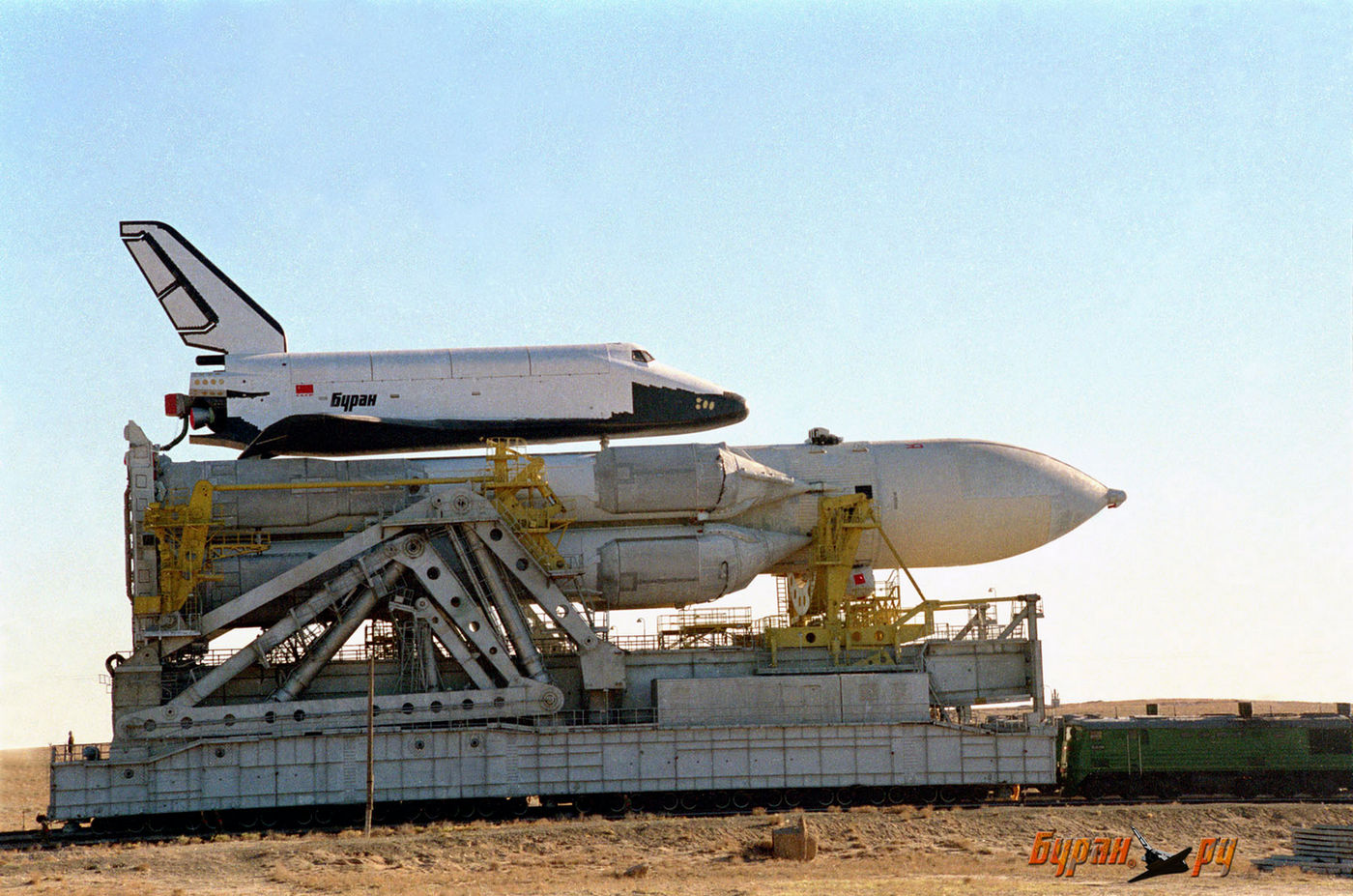
Even before the first Apollos landed on the moon, the NASA budget began to decline. The leadership of the space agency, it became clear that they need a much cheaper transport for launching people and cargo into space than the launch vehicle "Saturn-5". The way out for this was seen in the implementation of one of the original stages of reaching the moon in terms of Werner von Braun, namely in the creation of a reusable ship.
It was difficult to finance the entire NASA project, and the US Air Force also needed a new heavy carrier at that moment, so the agency agreed to increase the payload capacity and dimensions of the cargo space shuttle to the characteristics of the promising satellite KH-11and the Air Force, in turn, provided part of the financing for the development and provided the Shuttle with additional orders. The contract at that moment seemed to be beneficial for both parties, although it will play a cruel joke with the project in the near future. But now is not about that.
Looking at the open access characteristics of the American shuttle and the fact that the military participated in this project, and also comparing this data with the characteristics of its satellites and the Almaz stations visited , the Soviet leadership came to the conclusion that the Space Shuttle can be used for inspection and removal them from orbit. By the time of construction in 1976 of the shuttle analogue for the test flights of the Enterprise, it finally concluded that it is impossible to leave this project without an answer, and you need to create your own analogue of the space shuttle.
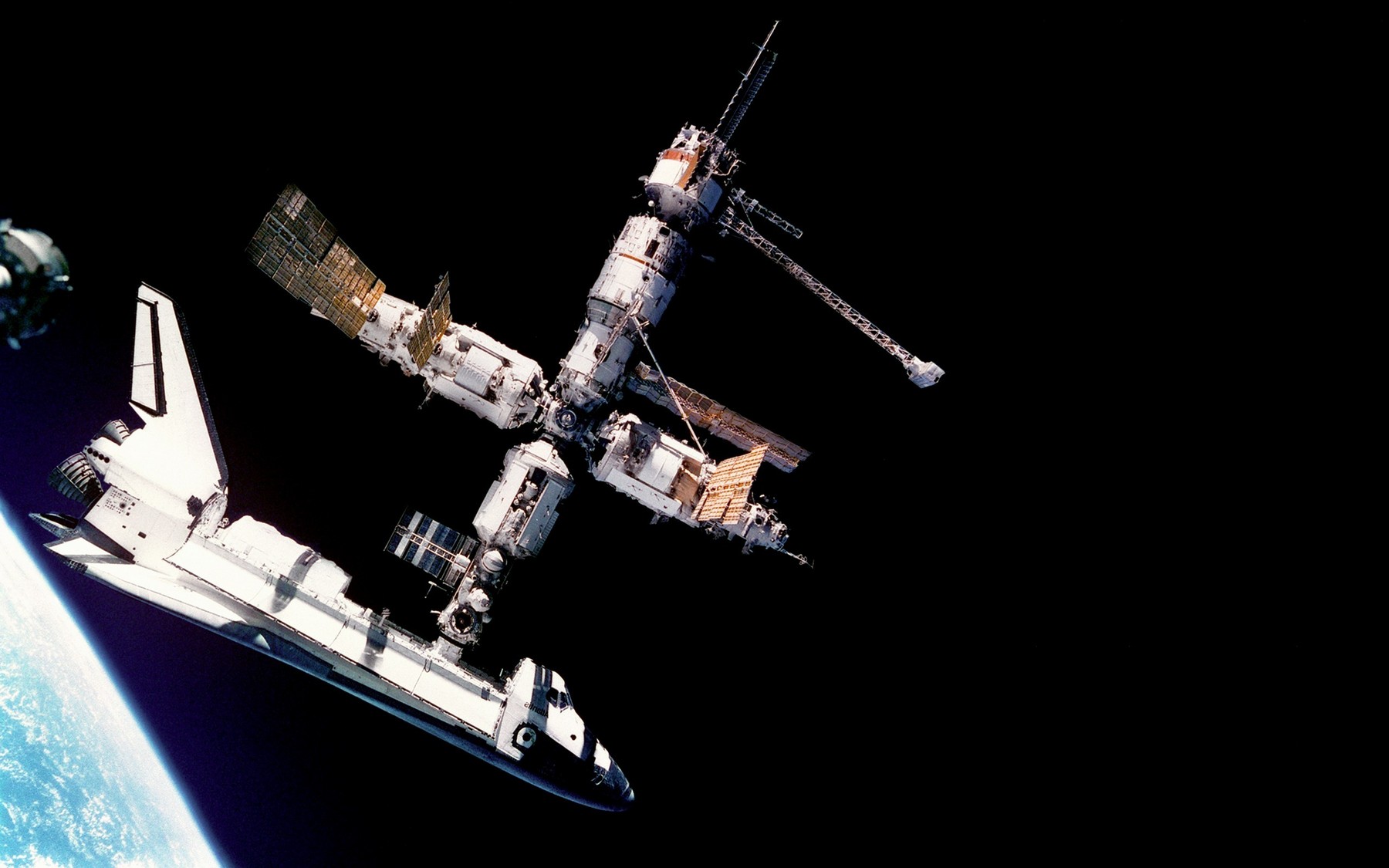
Space Shuttle and Mir Station .
It should be noted that in order to create the Buran, another, very exotic reason is also called: the possibility of the Shuttle diving into the upper atmosphere with a nuclear bomb dropping onto Moscow. There are several legends around this version: that visiting astronauts visiting the USA saw the scheme of such a “dive” on one of the posters (which happened to be on their way by chance or was “planted” by the American side intentionally), and also that one of the Shuttles did dive 1985 - shortly before the Challenger disaster. One way or another, but the Space Shuttle would be incredibly difficult to perform such a maneuver with certain modifications, and an ordinary satellite could be equipped with a nuclear weapon more easily and cheaply, so this version looks very doubtful.
The exact range of military missions of the Shuttles was unknown, therefore, as previously in the cases with the V-2 rocket and the B-29 bomber , the analog was ordered as close as possible to the original. Especially for the creation of the Energy-Buran system, the Molniya Scientific Production Association was formed , and G.Ye. Lozino-Lozinsky, previously engaged in the development of the aerospace system "Spiral". 70 ministries and departments, 1286 enterprises and about 1 million people were involved in the development, and in one way or another indirectly up to 3.6 million people worked on the project!
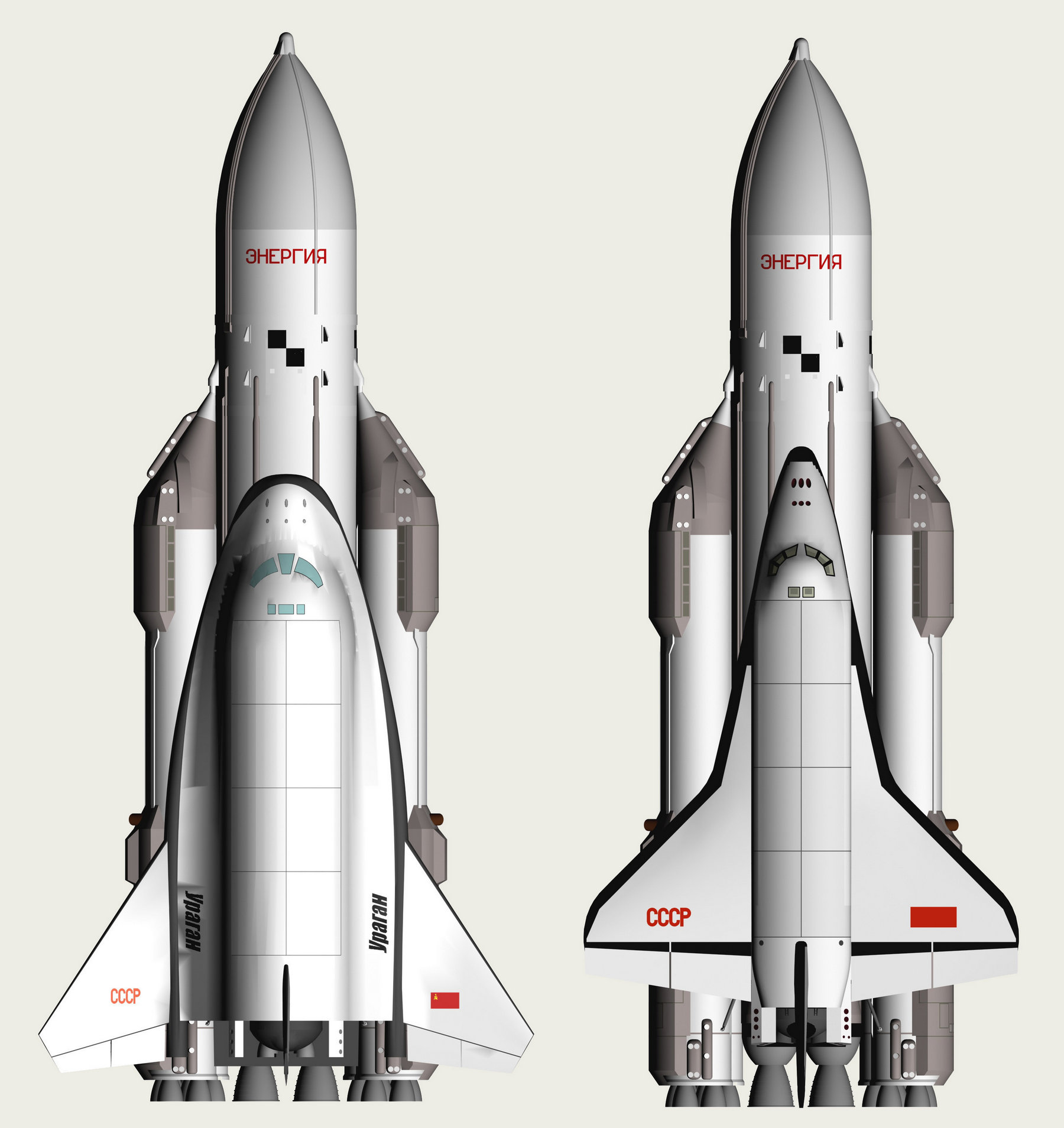
Lozino-Lozinsky wanted to offer his project “Hurricane”, modified from “Spiral” to the overall and weight requirements of the payload, and created for testing of heat-insulating tiles in the conditions of entering the atmosphere a series of ships “BOR-4” repeating “Spiral”, which in the nasal rounding, as well as the supposed “Buran”, had a smaller form. But the country's leadership remained adamant, and in the next series of ships "BOR-5" had to return to the constructive scheme of "Buran".
It was impossible to completely repeat the construction of the Space Shuttle under the conditions of Baikonur inclination, and the Soviet industry did not have any experience in creating solid-fuel boosters, so it was decided to replace them with a kerosene-oxygen first stage. RD-0120 hydrogen engines also turned out to be more RS-25 Shuttle engines , and therefore they had to be transferred from the spacecraft to the second stage. As a result, they turned out to be disposable, but under the conditions of the almost exclusive purpose of the Energy-Buran system, this was not so important. As a bonus, in this scenario, the Soviet Union received an Energia launch vehicle capable of putting up to 100 tons into orbit.
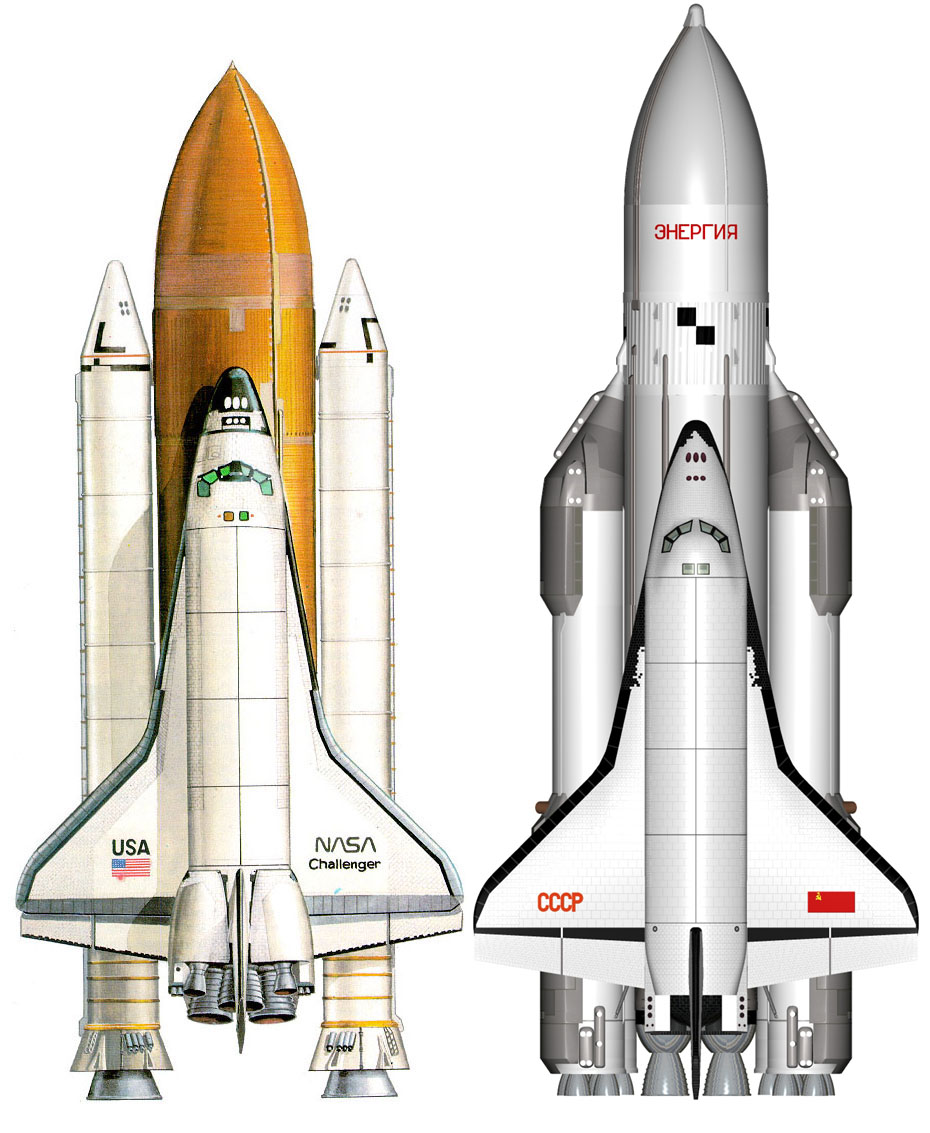
The final view of the "Shuttle" and "Buran".
By May 15, 1987, the first model of the Energia launch vehicle was already ready, but the Buran was still being built, so for the first test launch it was decided to use the Skif dynamic laser platform, which received the designation Polyus . The rocket worked without any remarks, but the Pole did not go into orbit due to a software error, as a result of which, instead of accelerating to orbital speed, it braked and fell into the Pacific Ocean. However, for the main goal of the project, this was an unequivocal success - Energia showed its readiness to launch the spacecraft into orbit.
By October 29, 1988, both the ship and the launch vehicle were ready. It is worth noting that participating in the trials and preparing for the flight on the "Buran" Igor Volk and Alexey Leonov sent a letter to the leadership of the country to be allowed to participate in this flight, but they were denied this. Igor Volk not only participated in the “training” of the aircraft-like automatic landing on the airfield, but also made a space flight on the Soyuz T-12 , during which he proved the possibility of piloting the ship immediately after the space flight, sitting at the helm of the helicopter, as well as Tu-154 and MiG-25 aircraft (while the MiG cockpit was plastered in such a way as to simulate visibility from the Buran cockpit).
So, at 06:24 Moscow time, the prestart countdown shows already less than a minute before launch, but suddenly it is interrupted by automation. It turns out that the instrument cluster of the aiming platform did not move away from the rocket, which caused the launch to stop. The launch was postponed for 17 days.
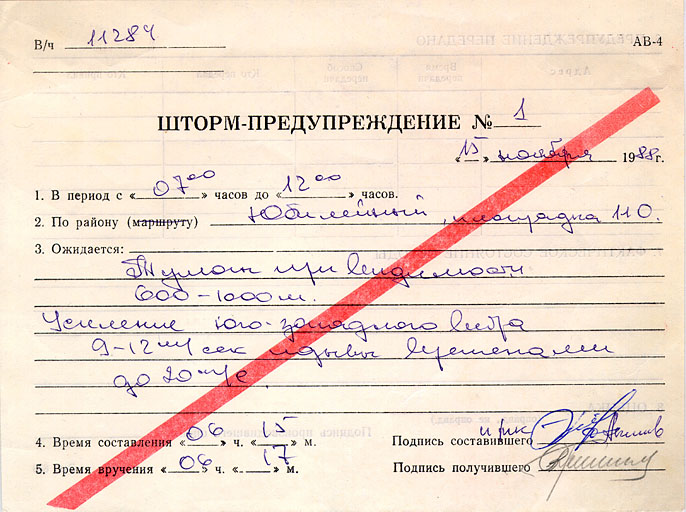
November 15, 1988 "Energy" with the "Buran" on board was again ready to launch. This time, the entire countdown went according to plan, with the exception of the weather - a storm warning was transmitted to the launch management under the painting: fog with a visibility of 600-1000 m and low clouds, south-westerly wind of 9-12 m / s with gusts up to 20 m / s , and on the ship, among other things, icing with a thickness of 1-1.7 mm was detected. In similar cold conditions, the Challenger shuttle died less than 3 years ago, but Buran did not have solid-fuel boosters (which then led to a catastrophe) and the launch was risky to postpone, as there was a risk that the country's leadership could completely cancel it, so it was decided decision to ship all the same run.
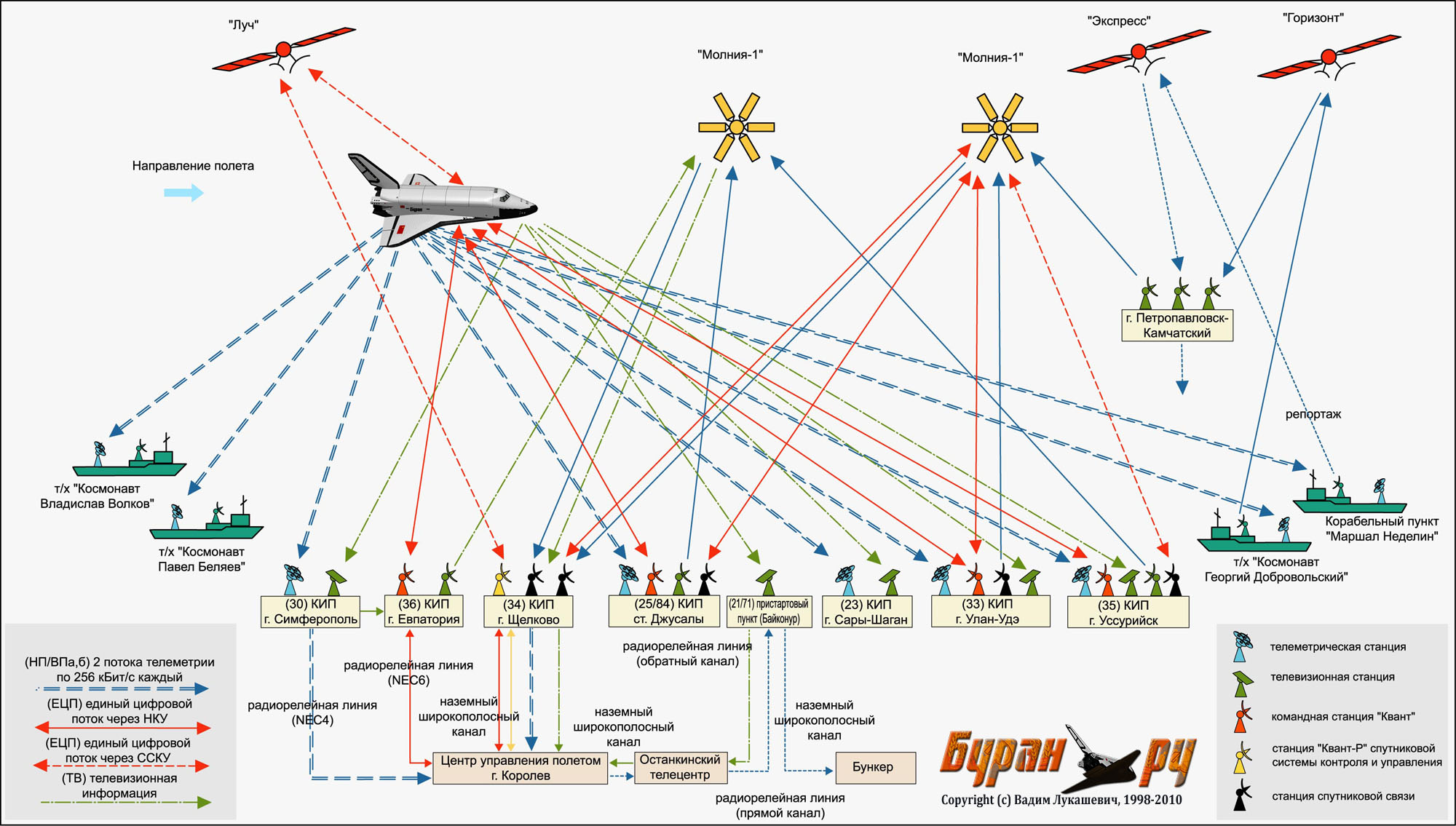
During the flight, six ground tracking stations, 4 research vessels and 5 satellites were used. The landing of the ship was removed from the AN-26 and MiG-25.
The launch took place at 06:00 Moscow time and was perfect. After 467 seconds after the start, the Energia engines shut down, and after another 15 seconds, the Buran separated from it and set off for free flight. After another 3 minutes, he reached the apogee of the trajectory and, with a 67-second pulse, switched to orbit at 251-263 km with an inclination of 51.64 °. The ship turned its bottom to the Sun and in 1.5 turns made 4 communication sessions with the earth, the entry of which the data necessary for flight and landing were transmitted aboard, and the telemetry and television signal from the pilot camera installed on the spot.
Then he began to prepare for landing: the centering of the ship was changed by transferring fuel from the bow tanks to the feed tanks. At 08:20 over the Pacific Ocean, the Buran turned back and forth and gave a braking impulse by switching on the shunting engines for 158 seconds, after which it turned back, preparing to enter the atmosphere.
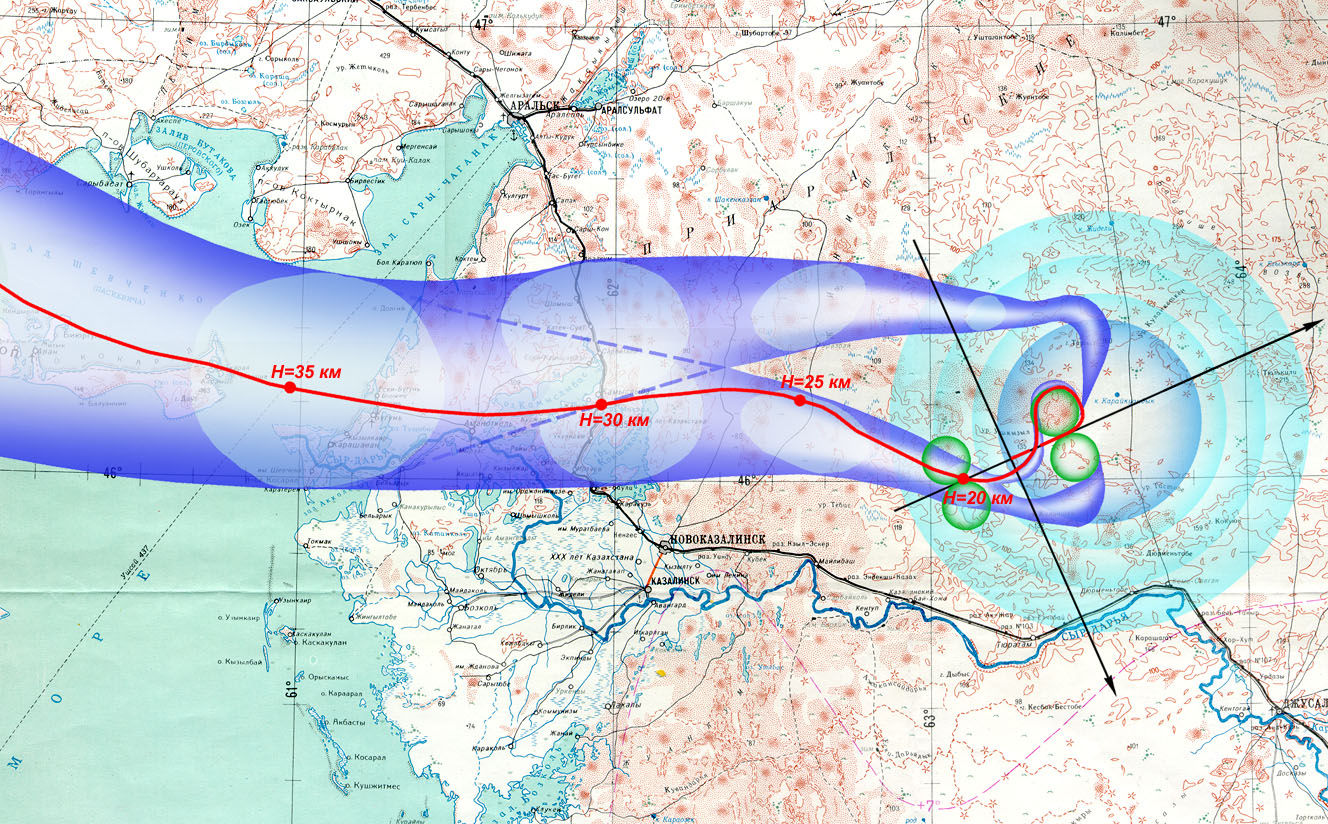
Like the Space Shuttle, the entry of the Buran into the atmosphere occurred with a large roll along a zigzag path. This was done to reduce the lift of the wings, which was required for the rapid passage of the upper layers of the atmosphere, in which the ship was surrounded by high-temperature plasma and could simply "overheat". The landing was also successful, although it was not without curiosity: after passing the plasma formation section at an altitude of 50 km, Buran again established contact with the ground and received data on the weather over the airfield (strong wind of 15 m / s with gusts up to 20 m / with). In such conditions, the on-board computer decided to enter the lane from the opposite side. Having completed a sharp maneuver for this, shortly before landing, the ship was over the receiving stations and was lost by them, the MiG-25 pilot Magomed Tolboev also lost the ship in the clouds.
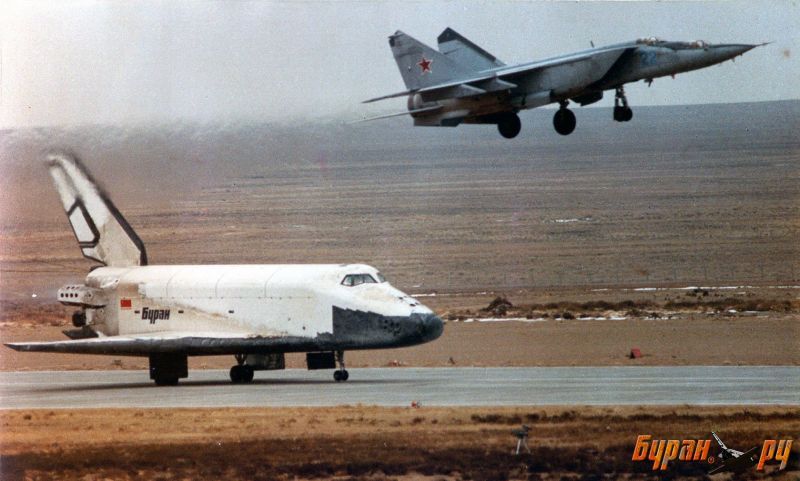
The landing of the Buran was so smooth that the automatic release of a parachute tied to the compression ratio of shock absorbers only worked when the ship began to lower its nose and the landing gear sank under the weight of the ship. Despite the strong wind, flying almost 100 thousand km, the ship touched the runway of the Baikonur airfield with a deviation of only 9.4 m to the right and with a distance of 190 m from the calculated point of contact.
The next launch could have taken place already in 1990 or 1991, but alas, this was not to be the case: in 1991, work on the project was suspended, and on May 25, 1993, it was completely stopped. In total, by the beginning of 1992, 16.4 billion Soviet rubles (about 2 trillion rubles in 2016 prices) were spent on the Energiya-Buran project for 16 years, and the infrastructure created during development allowed the ship to be launched once every 2 weeks! In "Buran" 400 new inventions were also applied.
Some of these developments according to the program were used with benefit: the “half” of the RD-170 - the engine used on the Energy side blocks - under the name RD-180was created and used so far on the American Atlas-5 launch vehicle. The funds obtained from the sale of rocket engines made it possible to save the collectives and production facilities in the lack of money in the 90s. Also, the side blocks of the first stage of Energy under the name "Zenit-2" were used for launches from Baikonur and "Sea Launch" . At the moment , the commercial firm S7 Space is already temporarily reviving the production of Zenit , in order to reach break-even more quickly, and to create a client base for the Soyuz-7SL launch vehicle currently under development. Flying "Buran" in 1991.
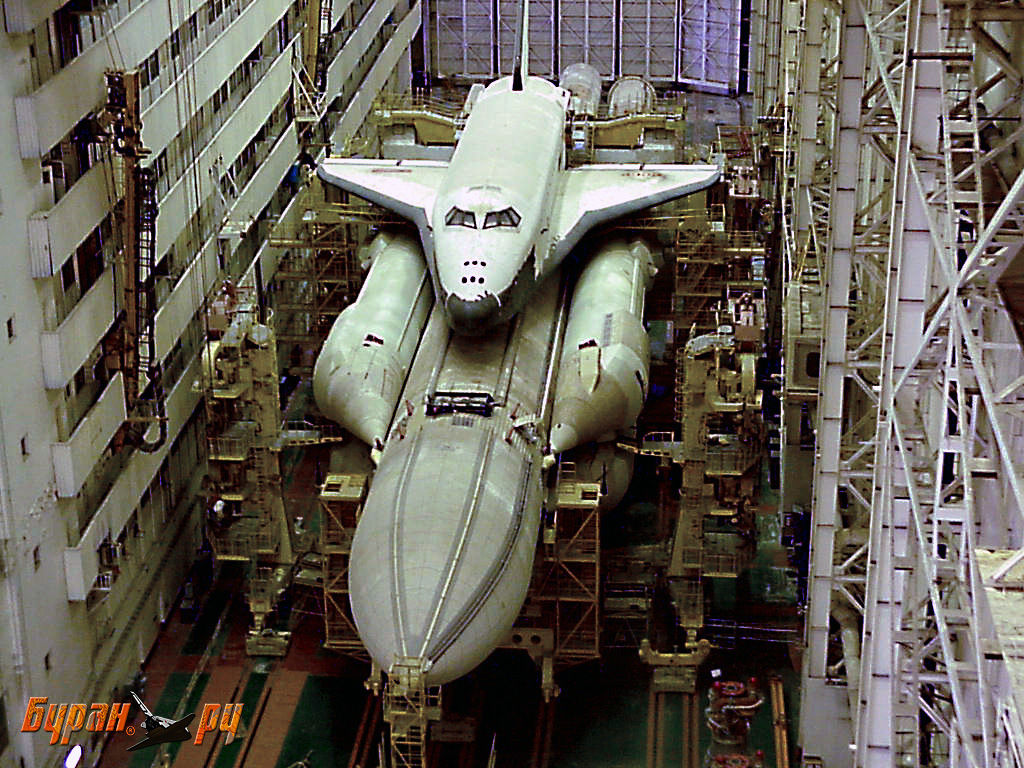
However, far from everything was able to preserve and apply for the benefit: this is how NPO Lightning is now in decline, and even though the department for reusable injecting equipment was decided to be revived at the base of Khrunichev, but we still have no intelligible plans for creating a reusable system. Since the time of collapse for the program "Energy-Buran" there were many attempts to create something like this: the side blocks "Angara" carrier rocket were going to put on the airfield on the wings (is planning to do for the side Energy blocks), also offers a reusable system with air start " MAKS ” and the reusable spacecraft Clipper , but none of this was ever realized.
We have not yet succeeded in reviving the technology of using hydrogen-oxygen fuel: although in the same 90s we developed the hydrogen upper stage for the Indian launch vehicle "GSLV" , but we are going to build the hydrogen upper stage "KVTK" not earlier than 2024 , and attempts to restore the hydrogen engine RD-0120 is no longer undertaken.
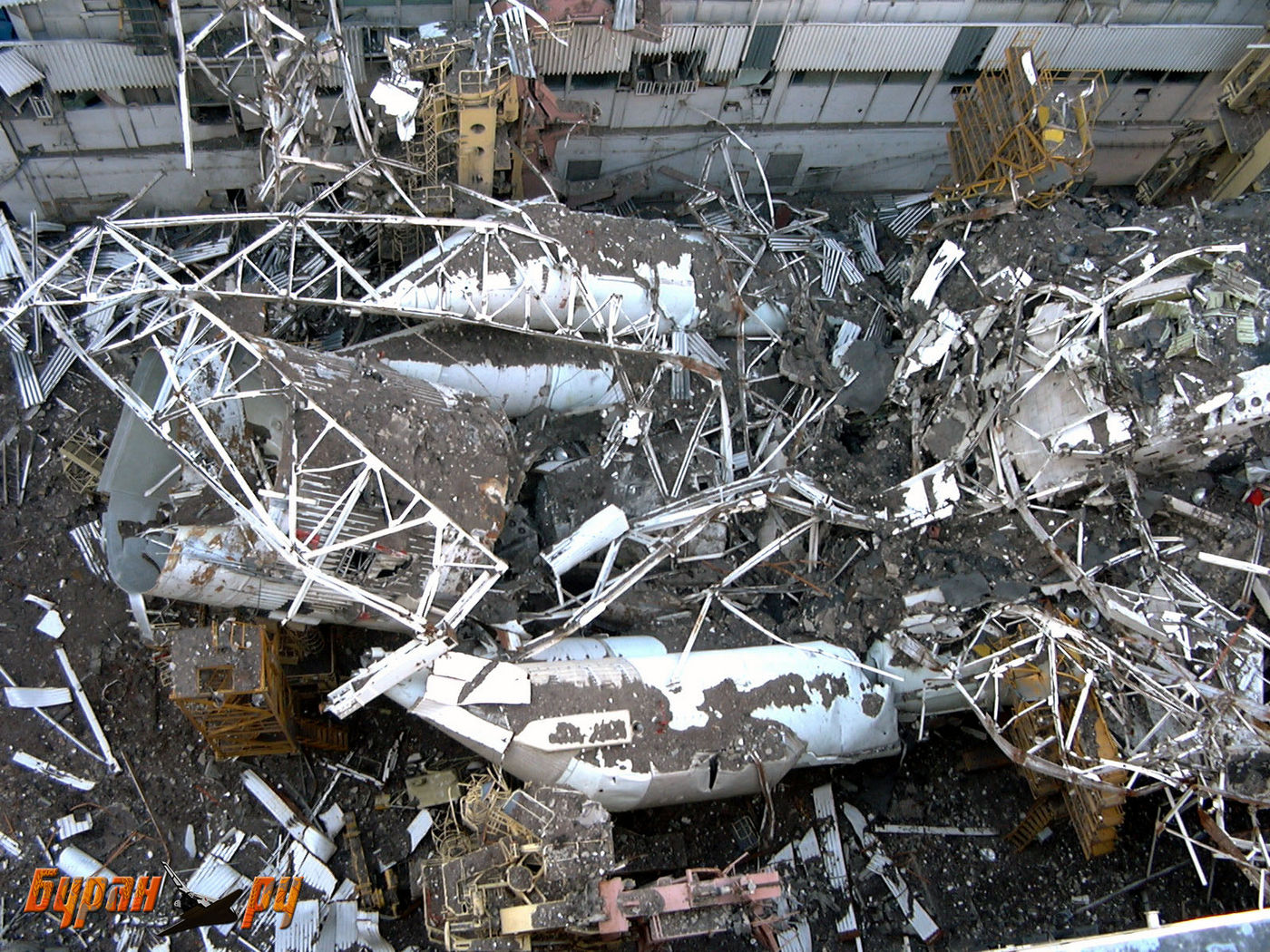
In the spring of 2002, the leaking roof of the assembly and test building of site No. 112 of Baikonur, where the Buran flying into space assembled with the Energy rocket prototype was stored, collapsed due to violations during the repair. 10 tons of roofing material stored in one place, coupled with heavy claydite, which absorbed moisture from recent rains, caused the collapse of one of the roof spans. Due to the destruction of the launch vehicle tank caused by this, Energy and structural shortcomings of the roof structure itself, followed by two more spans out of five. Under the roof of the MIK, which once served as the assembly point for all three Buran series orbiting ships, were the ship itself, the various flight components of the Energia launch vehicle, and all 8 members of the crew that performed the repairs were buried. From the roof of a fall from a 70-meter height "Buran" was almost completelydestroyed - it was no longer restored. The MIC itself was about to be restored, but only the 3rd span of its roof could be repaired.
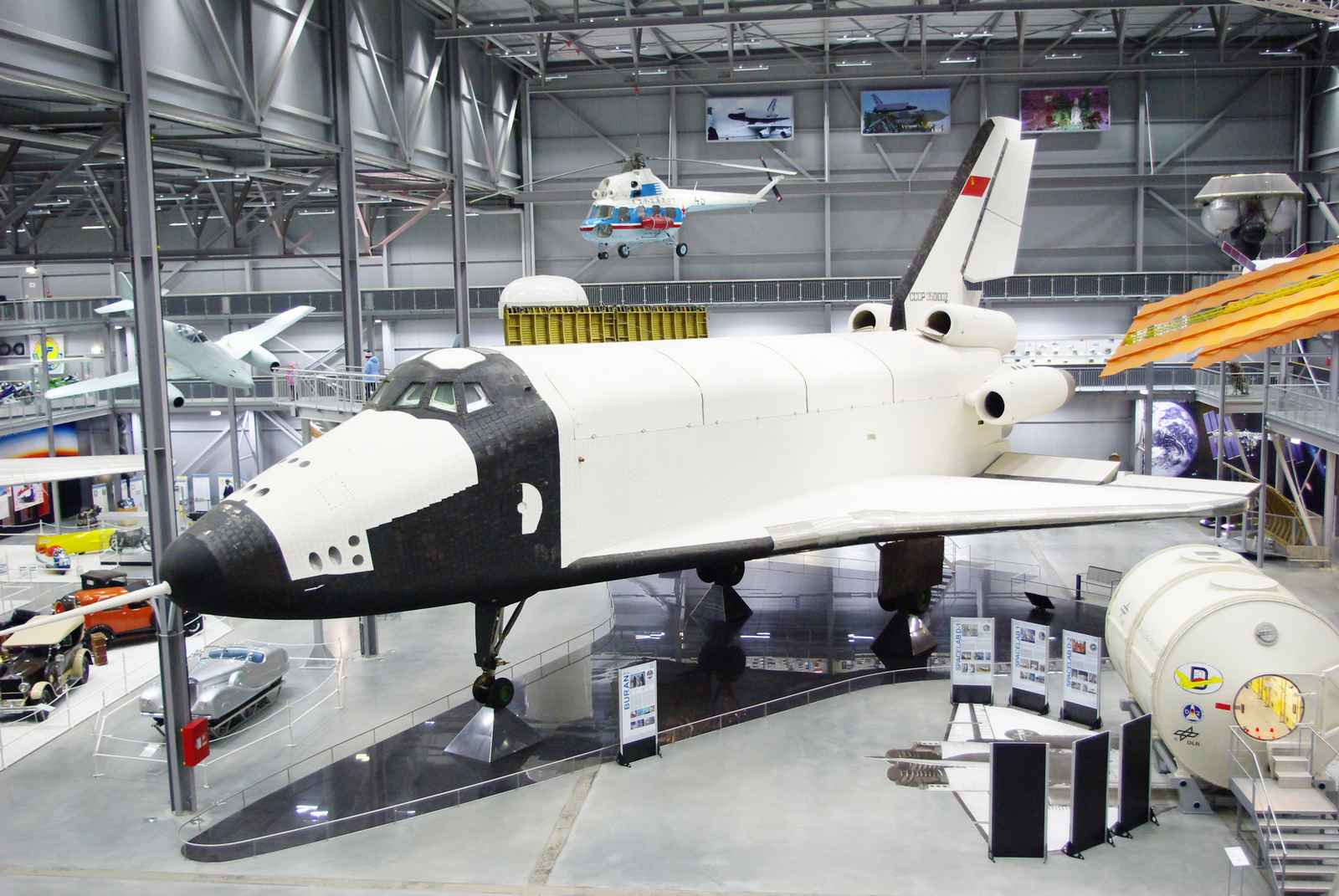
The atmospheric analogue aircraft Burana BTS-002 was also lost for us: after several operations, during which he, in particular, attended the Sydney Olympiad, the analogue aircraft was owned by the museum of technology in Speyer (Germany), where he has been from 2008 to this day.
3rd flight model - "Baikal"- For a long time, it stood at the workshops of the Tushinsky Machine-Building Plant, from where it was sold to a pharmaceutical company and ended up on the banks of the Khimki Reservoir in 2004. Later in 2011 he was transferred to the LII. Gromov, where they were going to restore the exhibition "MAKS-2013", but even these plans did not come true.
Calling the Space Shuttle program completely successful also fails - the re-sized ship created for the demands of the military turned out to be expensive to maintain and could not reach the planned launch frequency, which the military "helped" again by refusing to use the ship after the Challenger disaster . And the frequency of launches was a key factor in ensuring the economic benefits of this project. Also, the need to fit within the existing budget for the development of the Space Shuttle forced its creators to use side solid fuel boosters, which not only proved to be very expensive to maintain (comparable to the creation of a new accelerator), but also caused one of its 2 disasters.
However, it could not be called a complete failure either, since many scientific projects like the famous Hubble telescope would have been impossible to implement without such a lifting medium. And in the case of Hubble himself - and without the shuttle itself, capable of carrying out repairs in orbit. Also, all 4 of the surviving "Shuttles" hit the American museums, where they remind their visitors about this beautiful, but not completely successful project. Something for us is already irretrievably lost, but something can still be saved! At the moment under the threat turned out to be the Central Air Force Museum in Monino , in the territory of which the flight analogue orbital vehicle "Spiral" - MiG-105.11

. The exhibits of this museum are intended to be transported to the Patriot Military-Patriotic Recreation Park, located 90 km away. Such “little ones”, as an analogue of the “Spiral”, may be transported and do not threaten, but here large machines will obviously have to be cut into pieces, which threatens to turn into serious consequences for their condition.
Among the unique exhibits of Monino there is a Tu-144 aircraft , the first to start carrying passengers, the only T-4 supersonic bomber raised in the sky , the M-55 high-altitude subsonic reconnaissance aircraft produced in 5 copies and the VBA-14 experimental amphibian aircraft existing in 2 copies., as well as many other cars with a unique history. The loss of each of these exhibits may be an irreplaceable loss for the history of our aircraft.
Links
A more detailed history of the creation of "Buran" and its historical flight on the website "Buran.Ru".
Description of the process of landing a spacecraft on the example of the "Space Shuttle".
And of course the book “Space Wings” by V.P. Lukashevich and I.B. Afanasyev, which is the source of countless details of the projects "Spiral" and "Buran", as well as many other projects to create reusable space-based systems.
Speech Vadim Lukashevich in the Moscow Space Club on the 30th anniversary of the flight "Buran".
